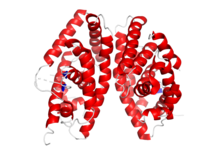| LXRα (nuclear receptor subfamily 1, group H, member 3) | |||||||
|---|---|---|---|---|---|---|---|
 LXRα-RXRβ heterodimeric structure (PDB 1UHL). | |||||||
| Identifiers | |||||||
| Symbol | NR1H3 | ||||||
| NCBI gene | 10062 | ||||||
| HGNC | 7966 | ||||||
| OMIM | 602423 | ||||||
| RefSeq | NM_005693 | ||||||
| UniProt | Q13133 | ||||||
| |||||||
| LXRβ (nuclear receptor subfamily 1, group H, member 2) | |||||||
|---|---|---|---|---|---|---|---|
| Identifiers | |||||||
| Symbol | NR1H2 | ||||||
| Alt. symbols | UNR | ||||||
| NCBI gene | 7376 | ||||||
| HGNC | 7965 | ||||||
| OMIM | 600380 | ||||||
| RefSeq | NM_007121 | ||||||
| UniProt | P55055 | ||||||
| |||||||
The liver X receptor (LXR) is a member of the nuclear receptor family of transcription factors and is closely related to nuclear receptors such as the PPARs, FXR and RXR. Liver X receptors (LXRs) are important regulators of cholesterol, fatty acid, and glucose homeostasis. LXRs were earlier classified as orphan nuclear receptors, however, upon discovery of endogenous oxysterols as ligands they were subsequently deorphanized.
Two isoforms of LXR have been identified and are referred to as LXRα and LXRβ. The liver X receptors are classified into subfamily 1 (thyroid hormone receptor-like) of the nuclear receptor superfamily, and are given the nuclear receptor nomenclature symbols NR1H3 (LXRα) and NR1H2 (LXRβ) respectively.
LXRα and LXRβ were discovered separately between 1994-1995. LXRα isoform was independently identified by two groups and initially named RLD-1[1] and LXR,[2] whereas four groups identified the LXRβ isoform and called it UR,[3] NER,[4] OR-1,[5] and RIP-15.[6] The human LXRα gene is located on chromosome 11p11.2, while the LXRβ gene is located on chromosome 19q13.3.
- ^ Apfel R, Benbrook D, Lernhardt E, Ortiz MA, Salbert G, Pfahl M (October 1994). "A novel orphan receptor specific for a subset of thyroid hormone-responsive elements and its interaction with the retinoid/thyroid hormone receptor subfamily". Mol. Cell. Biol. 14 (10): 7025–35. doi:10.1128/mcb.14.10.7025. PMC 359232. PMID 7935418.
- ^ Willy PJ, Umesono K, Ong ES, Evans RM, Heyman RA, Mangelsdorf DJ (May 1995). "LXR, a nuclear receptor that defines a distinct retinoid response pathway". Genes Dev. 9 (9): 1033–45. doi:10.1101/gad.9.9.1033. PMID 7744246.
- ^ Song C, Kokontis JM, Hiipakka RA, Liao S (November 1994). "Ubiquitous receptor: a receptor that modulates gene activation by retinoic acid and thyroid hormone receptors". Proc. Natl. Acad. Sci. U.S.A. 91 (23): 10809–13. Bibcode:1994PNAS...9110809S. doi:10.1073/pnas.91.23.10809. PMC 45115. PMID 7971966.
- ^ Shinar DM, Endo N, Rutledge SJ, Vogel R, Rodan GA, Schmidt A (September 1994). "NER, a new member of the gene family encoding the human steroid hormone nuclear receptor". Gene. 147 (2): 273–6. doi:10.1016/0378-1119(94)90080-9. PMID 7926814.
- ^ Teboul M, Enmark E, Li Q, Wikström AC, Pelto-Huikko M, Gustafsson JA (March 1995). "OR-1, a member of the nuclear receptor superfamily that interacts with the 9-cis-retinoic acid receptor". Proc. Natl. Acad. Sci. U.S.A. 92 (6): 2096–100. Bibcode:1995PNAS...92.2096T. doi:10.1073/pnas.92.6.2096. PMC 42430. PMID 7892230.
- ^ Seol W, Choi HS, Moore DD (January 1995). "Isolation of proteins that interact specifically with the retinoid X receptor: two novel orphan receptors". Mol. Endocrinol. 9 (1): 72–85. doi:10.1210/mend.9.1.7760852. PMID 7760852.